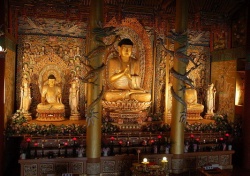Ti-lun
Ti-lun .The conventional short form of the title of a Buddhist scripture in Chinese translation. The full title is Shih-ti ching lun (Treatise on the Scripture of the Ten Stages, Taishō 1522), a commentary by the Indian Buddhist scholar Vasubandhu. This commentary aroused considerable interest among Chinese Buddhist scholars, and called attention to Buddhabhadra's translation of the Avataṃsaka Sūtra (Chinese, Hua-yen ching) completed around 418, since the eighth fascicle of this work was the locus classicus for the ten stages (bhūmi) through which a Bodhisattva passes on the way to full Buddhahood. Thus, Ti-lun scholars generally were familiar with the Avataṃsaka as well. During the T'ang dynasty, when the Hua-yen school was established on the basis of the Avataṃsaka Sūtra, it quickly absorbed Ti-lun scholars into its fold.
Chin., lit. “School of the Treatise on the Bhumis”; school of early Chinese Buddhism, which was based on a commentary by - Vasubandhu on the - Dashabhumika. This commentary was translated into Chinese in 508 by Bodhiruchi, Ratnamati, and Buddhasanta. A branch of this school became the predecessor of the Hua-yen school.
The Ti-lun school adopted the basic philosophy of the - Yogachara, particularly the theory of the storehouse consciousness ( alaya-vijhana), concerning which there were different views within the school. The northern branch, represented by Tao-ch’ung, a student of Bodhiruchi, took the position that the storehouse consciousness is not real - it is false and separate from suchness ( - tathata) - and - buddha - nature is first acquired upon attaining buddhahood; thus it is not inborn. The southern and more important branch of the school under Hui-kuang, a student of Ratnamati, saw the storehouse consciousness as real and identical with suchness, and buddha-nature as inborn. Out of this southern branch, the Hua-yen school developed; the northern branch was absorbed by the Fa-hsiang school.
